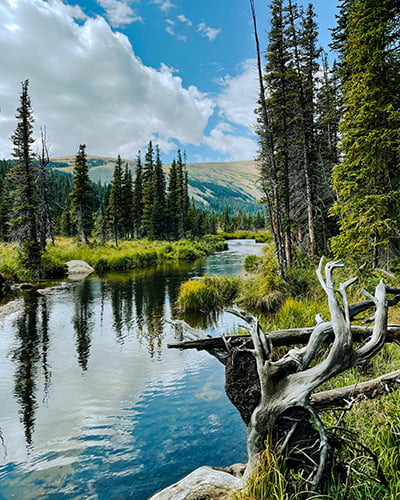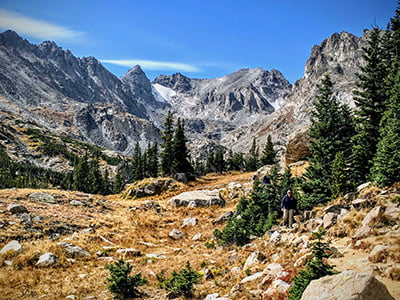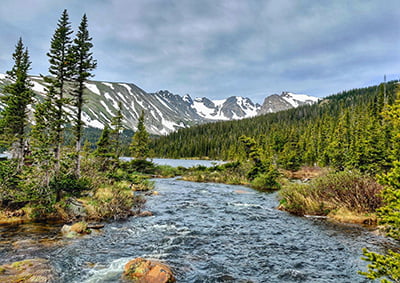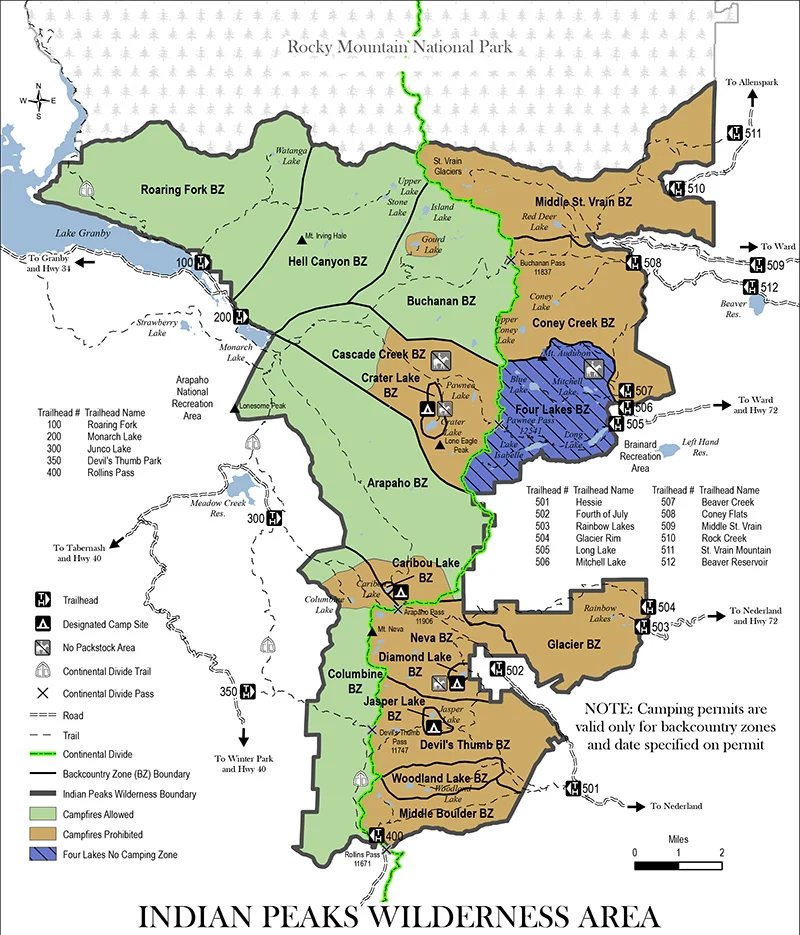The Indian Peaks Wilderness in Colorado is an outdoor lover's dream and a hikers paradise! From the moment you set foot on the trails, you'll be transported to another world. With its breathtaking views, lush landscapes, and various trails, the Indian Peaks offers something for everyone.
This magnificent wilderness area offers a variety of trails that cater to every skill level and interest. Whether you're looking for a scenic picnic spot, a challenging hike, or a peaceful place to fish, below, we will share everything you need to know about the Indian Peaks Wilderness area.
About the Indian Peaks Wilderness
Situated within the Arapaho and Roosevelt National Forests, the Indian Peaks Wilderness became part of the National Wilderness Preservation System in 1987 and is a 73,391-acre protected slice of mountain majesty in Colorado's Front Range. It's sandwiched between the James Peak Wilderness to the south and Rocky Mountain National Park to the north. To the east, the slopes descend toward the Front Range Urban Corridor, where most Coloradans live.
The wilderness area has two distinct sides since it is draped over the Continental Divide, and no roads cross it from east to west. The eastern side is more popular due to its proximity to cities like Boulder and Denver. The western side is farther but is just as wild and spectacular as the eastern side.
Best Time to Visit
Embark on a journey through the breathtaking Indian Peaks Wilderness at any time of year, but summertime is when the magic truly shines. While June and July are prime months for exploration, June can present some challenges with lingering snow in higher elevations. By July, the snow had melted away, revealing crowded trails and pesky mosquitoes. For a truly unforgettable experience, plan your visit in August or September. Enjoy the crisp, dry air, bug-free hikes, and peaceful trails without the hustle and bustle of peak season. Although, be prepared for a refreshing chill in the air on some early mornings!
Experience the stunning beauty of Indian Peaks Wilderness at its finest by avoiding crowds. Plan your visit during the week or rise with the sun on weekends to beat the crowds for a serene escape. Although thunderstorms are common, they are not a daily fixture, leaving ample opportunity for clear skies and breathtaking views. Take advantage of a peaceful day by waking up before dawn and trekking above the treeline to witness a stunning sunrise. And as the day comes to a close, settle in for a breathtaking sunset behind the majestic peaks of the wilderness for a truly unforgettable experience.
Things to Do
Hiking

The Indian Peaks Wilderness is packed with outdoor opportunities. The best way of seeing the highlights is via one of the region's many hiking trails. Mount Audubon, Isabelle lake, Lake Dorothy, and Gibraltar Lake are beautiful destinations on the east side of the wilderness. Crater Lake, Mount Irving Hale, Foxpark, and Corona Pass are beautiful destinations on the western side. In general, the trails on the western side are longer and tougher. Yet, the scenery is often more remarkable, especially in the Crater Lake region. There, vertical spires of rock seem to shoot straight into the stratosphere.
Here are some popular trails:
Brainard Lake: This is a popular trail that offers great views of the Indian Peaks, as well as several alpine lakes and meadows. Families will enjoy the bountiful scenery and mellow trails around Brainard Lake. They are perfect for picnics, wildlife viewing, and casual walks.
Jasper Lake: This trail takes you to a secluded mountain lake surrounded by towering peaks.
Mount Audubon: This trail offers a challenging hike to the top of Mount Audubon, which provides panoramic views of the Indian Peaks and the surrounding landscape.
Arapaho Pass: This trail takes you through beautiful alpine meadows and over a high mountain pass, offering great views of the Indian Peaks and the surrounding wilderness. From the South Arapaho Trailhead, you can reach the North Arapaho Peak.
Diamond Lake: Diamond lake trail takes you to a stunning mountain lake surrounded by peaks, with opportunities for fishing and picnicking along the way.
Navajo Lake: This trail takes you to a beautiful high-mountain lake surrounded by peaks, with opportunities for fishing, hiking, and backpacking. With this trail, you can access Navajo Peak, with approximately 8 miles round trip.
South Boulder Creek: This trail takes you along a beautiful creek in a remote area of the Indian Peaks, with opportunities for fishing, hiking, and backpacking.
Blue Lake: This trail takes you to a stunning alpine lake surrounded by peaks, with opportunities for fishing and hiking.
Rainbow Lake Trail: This is a 4 miles round trip, family-friendly hike that takes you to four scenic mountain lakes and leaves at Rainbow Lakes Campground. This moderate trail leads visitors through lush forests and rolling meadows, offering breathtaking views of the surrounding wilderness and the iconic Rainbow Lake.
Lone Eagle Peak: A majestic mountain with an elevation of 13,000 feet, Lone Eagle Peak is one of the tallest mountains in the Indian Peaks Wilderness. Offering breathtaking views of the surrounding landscape, it passes many waterfalls, including Cascade Falls, making it a popular destination for hikers and mountaineers.
Snow Sporting
Snowshoeing, cross-country skiing, and backcountry skiing are popular in the winter. Winter conditions can be extreme, with low temperatures and consistent wind above the treeline. This part of Colorado is very windy, so bring windproof layers! Walking the Brainard Lake or Left Hand Reservoir Roads is a relatively easy winter snowshoe.
Embracing The Hues of Autumn

As summer fades into fall, the Indian Peaks Wilderness transforms into a golden wonderland. The crisp air and golden Aspen trees paint entire hillsides in late September and early October, creating a natural canvas for the adventurous spirit.
Fishing
The Indian Peaks Wilderness is a fisherman's paradise, offering miles of pristine streams, alpine lakes, and scenic vistas. However, you may need to hike to some of the more remote ones. Cast your line in search of rainbow trout, brook trout, and cutthroat trout, or try your hand at catching the elusive native greenback cutthroat trout.
Camping

With miles of trails, serene meadows, and breathtaking vistas, this wilderness area offers a diverse range of camping experiences. There are several designated camping areas throughout the wilderness where visitors can set up camp and enjoy the beautiful surroundings. Permits are required for all overnight camping trips and can be obtained through the Boulder Ranger District Office or online.
Here are some of the most popular campgrounds:
Brainard Lake Recreation Area: This campground offers a variety of camping options, including car camping, backpacking, and walk-in camping. Brainard Lake is a popular destination for families and outdoor enthusiasts, with easy access to various recreational activities, including hiking, fishing, and boating.
Fourth of July Campground: Situated near the peaceful Fourth of July Creek, this is a popular destination for fishing and hiking. With easy access to the surrounding wilderness and various amenities, including fire pits and picnic tables, the Fourth of July Campground is a popular choice for those seeking a traditional camping experience.
Rainbow Lakes Campground: Located near the stunning Rainbow Lakes, this campsite offers visitors breathtaking views of the surrounding wilderness and access to a range of recreational activities, including fishing, hiking, and wildlife watching.
South St. Vrain Campground: This car camping campground is located in a peaceful forest setting, offering visitors a peaceful escape from the hustle and bustle of city life. With easy access to the surrounding wilderness and a variety of amenities, including fire pits and picnic tables, South St. Vrain Campground is a popular destination for those seeking a more serene camping experience.
Off-Roading
Off-roading is possible in areas near the wilderness. If you have a lifted 4WD truck, you can drive the Middle St. Vrain road, which is a tough challenge that gets to a few trailheads. There are large obstacles to navigate and several water crossings.
Wildlife Watching
The Indian Peaks Wilderness is home to a variety of wildlife, including elk, moose, bighorn sheep, mountain goats, mountain lions, mule deer, black bears, and snowshoe rabbits, making it a great place for wildlife watching and photography.
Rock Climbing
Mountain climbing in the Indian Peaks Wilderness of Colorado can be a challenging and rewarding experience for experienced climbers. Some of the popular peaks for climbing in the Indian Peaks Wilderness include Navajo Peak, South Arapaho Peak, Mount Audubon, and Pawnee Peak. These peaks offer a range of difficulty levels, from Class 2 hikes to more challenging Class 4 and 5 technical climbs.
Scenic Drive
The Corona Pass Road: One of the better ways to get beautiful views with less effort is to drive Corona Pass road outside of Winter Park. This 15-mile dirt road ascends to a parking area along the Continental Divide and above the treeline. An AWD or 4WD vehicle is recommended. From here, head north on the High Lonesome Trail for amazing long-range views of northern Colorado.
Peak to Peak Scenic Byway: This 55-mile scenic drive takes visitors through some of the most beautiful mountain scenery in Colorado, including the Indian Peaks Wilderness. The drive offers stunning views of the Front Range and provides access to several trailheads for hiking and outdoor activities.
Boulder Canyon Drive: This scenic drive takes visitors along Boulder Creek and provides access to several recreational areas, including the Boulder Reservoir and Betasso Preserve. The drive offers spectacular views of the Indian Peaks Wilderness and is a popular destination for picnicking, fishing, and wildlife viewing.
Switzerland Trail: This scenic drive takes visitors through the rolling hills and stunning mountain scenery of the Indian Peaks Wilderness. The drive offers stunning views of the surrounding peaks and provides access to several hiking trails, including the South Boulder Creek Trail and the Hessie Trailhead.
Eating Options
The best places to find food are in the towns nearest to the wilderness area. Nederland has the Crosscut Pizzeria and Taphouse, along with Busey Brews Smokehouse and Brewery. The town is east of the wilderness and close to the Hessie Trailhead, 4th of July Trailhead, Eldora Ski Resort, and Brainard Lake Recreation Area.
On the western side, the towns of Granby and Grand Lake are both close enough to provide services. Granby has a few excellent Mexican restaurants and Brickhouse 40. Grand Lake has the Sagebrush BBQ & Grill along with the historic and beautiful Grand Lake Lodge.
[ATTRACTION NAME] Map

How to Get There
The easiest way to reach the Indian Peaks Wilderness is by approaching from the east. Colorado's largest (international) airport, DIA, is two hours from here. The Hessie and 4th of July trailheads and Brainard Lake Recreation Area offer the fastest way to get into the wilderness.
Keep in mind the places closest to the big cities will have the most crowds.
Golden Tips
All About Timing
As with many popular places, there are good and bad times to visit. Traditionally, the weekends from June through August will be the busiest, and you'll often encounter full parking lots by 7 am these days. There's a shuttle service for Hessie and 4th of July Trailheads, which helps.
Visit Brainard Lake Recreation Area Tip
Brainard Lake Recreation Area is arguably prettier, but there are fees and a reservation system in the summer. You will be ticketed if you don't have them. You can avoid these by parking at the Gateway Trailhead for free, but it will add five miles (2.5 each way) to any outdoor journey.
The East Side
A fun alternative on the eastern side is to visit the tiny town of Allenspark and find the trailhead for St. Vrain Mountain. It's a 7-mile effort with several thousand feet of elevation gain. But at the top, you'll be rewarded with stunning views of the iconic 14,259-foot Longs Peak.
The Western Side
On the western side, Monarch Lake is the most popular spot. The parking lot is large but can easily fill up on summer weekends. A nice strategy is to book a campsite at Arapaho Bay on the shores of Lake Granby. The campsites are only 10 minutes from the trailhead. If both areas are completely full, park at the Roaring Fork Trailhead.
Altitude-related problems
Altitude sickness can occur in any area over roughly 8,000 feet. If you have pre existing heart conditions, check with your doctor BEFORE traveling to high-elevation areas. For most, altitude-related problems come in the form of headaches and occasional nausea. You can treat them with fluids and ibuprofen (if you're not allergic). But if the symptoms don't go away, go down in elevation until you feel better.
Wild-Life Activity
Animal sightings are common, but in all cases, never approach wildlife. Wildlife can be unpredictable.
On The Watch For Winter Storms For Winter Visits
Winter is a subdued time for the wilderness but offers a ton of peaceful outdoor opportunities. Having said that, winter storms can be severe. Always check the weather and dress in multiple layers.
Road Condition
In the summer, only Brainard Recreation Area has paved road access. Hessie, 4th of July, Monarch Lake, Rock Creek, Roaring Fork, and Corona Pass are all dirt roads. Make sure you drive slowly, or you'll risk a tire puncture.
Winter closures also impact access. Dirt Roads close in the winter and remain closed for longer; some may not open until July. The Brainard Recreation Area's main road is closed at the Gateway Trailhead. Both Hessie and the 4th of July Trailhead are blocked by winter snow. But the road is plowed to within a mile of Hessie Trailhead, making winter adventures possible.
On The Watch For Thunderstorms In Summer Months
Summer thunderstorms are common, especially in May, June, and parts of July. The general rule of thumb is to be off of a summit and descending by noon unless the weather forecast says otherwise.
Wildfires Encounter
The most common time for them is during the dry months of August, September, and early October. If an area is closed due to a wildfire, do not venture into it.
Weak or No Cell Reception
Cell reception may not be available in all parts of the wilderness. If you plan to hike one of the many tall mountains here, make sure you have all ten outdoor essentials. Tell someone where you're going and when you expect to be back.
Overnight Permits
Overnight visits require permits, which you can obtain through the Boulder Ranger District Office or online. They go on sale for the year around March. The number of permits available is limited, so it is recommended that you obtain your permits in advance, especially during peak camping season.
Camping Sites
Not all campsites are open year-round. For example, the Four Lakes Backcountry Zone is closed for camping between May through November.
